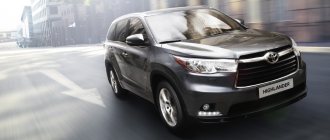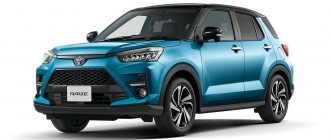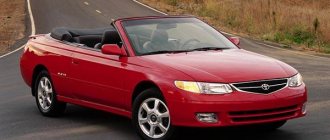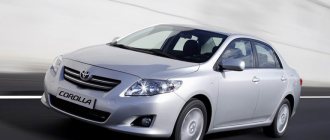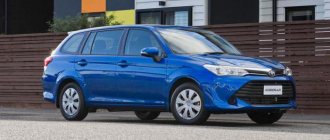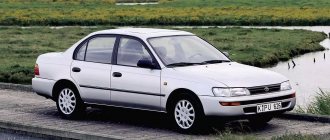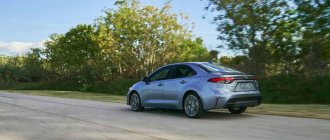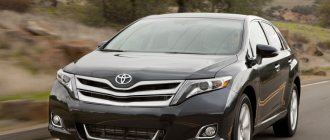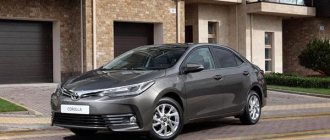This unusual, spacious car Toyota Venza assembled in the USA on the basis of Toyota Camry. It combines large dimensions, average cross-country ability and a high level of comfort. In Russia, the updated Toyota Venza is sold only with a 2.7-liter engine producing 185 hp, but in the cheapest configuration it has almost everything you want, including a panoramic roof.
This crossover station wagon is very quiet and is intended mainly for leisurely, comfortable trips. A very smooth ride and good suspension performance, together with a cozy interior, create a feeling of calm and abstraction from the outside world. All this makes this car a family car, suitable for long journeys.
However, its off-road qualities should not be overestimated. All-wheel drive is connected by a clutch, so it’s better not to go off-road.
A few words about the car
Experts do not consider the Venza a full-fledged crossover, but classify it as a station wagon with off-road capabilities, which occupies an intermediate position between classic SUVs and family cars. This is confirmed by the use of a platform from the popular Camry sedan in the production of the model.
At the same time, Japanese engineers classify the car as a crossover, citing engine characteristics, increased ground clearance and an all-wheel drive system. But experts do not recommend operating the machine in extreme conditions with increased loads.
Crossover, minivan or station wagon?
There is such a word as “eclecticism”. Without going into its Greek roots, in modern parlance it means “mixing.” A mixture of everything: styles, genres, trends. So this is the word that best suits the description and feeling of the Toyota Venza. Why? The fact is that the model was made as a super-universal car. It is worth recognizing that the designers and engineers succeeded. Venza, if desired, can easily be classified into several classes.
The manufacturer positions it as a crossover. Ground clearance of 20.5 cm and the presence of all-wheel drive modifications allow this. But with the same success it can be classified as a minivan. A huge single-volume interior, almost 5 meters long, trunk volume, with the rear seats folded, almost 2000 liters. And many people call Venza “Camry station wagon.” The comparison is controversial, although the technical parallels are obvious. In addition, the height is only 1.6 m, which is more of a sedan than a crossover. Plus a low, clearly not off-road, landing position. As you can see, the Venza can easily be classified into three different classes of cars.
Appearance
The exterior and interior design of the 2014 Toyota Venza received many positive reviews from car enthusiasts. Both the appearance and the internal content embody the classics of Japanese design, combining elegance and laconicism.
Exterior and body colors
Although the body design has not undergone major updates compared to its predecessor, a visual review can see several innovations. They make the exterior more bold and modern. The designers redesigned the radiator grille, headlights and bumpers.
The car also received updated wheel rims, turn signal repeaters on the side mirrors and a large number of chrome inserts in the interior trim.
Venza is sold in the following exterior colors:
- Metallic grey.
- Metallic red.
- Bronze brown.
- Black gloss.
Interior
The interior design of the Venza has undergone even fewer changes. The center console is reserved for a miniature screen of the on-board computer and infotainment complex, framed by air intakes.
You can install various software in the standard multimedia center to view the current weather forecast, listen to radio stations and solve other problems.
The instrument panel retains its analogue design in the traditional Japanese style.
The front seats are distinguished by well-thought-out ergonomics and good lumbar support. The back row of seats is quite spacious. It is equipped with a folding armrest with cup holders.
Toyota Venza 2014 car configurations
The crossover is available in 3 delivery packages:
- Elegance.
- Elegance Plus.
- Prestige.
Depending on the configuration, the technical equipment and cost of the model differ. The basic package includes functional climate control, 8 adjustments for the driver's seat, 3 sockets, good acoustics and built-in Bluetooth.
The next Elegance Plus package comes with leather trim for the interior and steering wheel, heated seats and the advanced Entune anti-theft system.
The premium version has all the options listed in the previous trim levels, as well as a number of additional ones.
Toyota Venza Specifications
The Toyota Venza is a family station wagon with crossover characteristics. The model, presented in 2014, embodies the best developments of the Japanese automaker and advanced technological achievements.
Dimensions
In terms of body dimensions, the crossover is almost identical to the Camry sedan. Its length is 4833 mm, width – 1900 mm, and wheelbase – 2755 mm. The height increased to 1610 mm, and the curb weight of the all-wheel drive version was 1900 kg.
Volumes
The luggage compartment of the Toyota Venza has a volume from 869 to 1025 liters, depending on the configuration. The fuel tank holds from 67 to 80 liters of fuel, depending on the vehicle configuration.
The luggage compartment has a volume of up to 1025 liters.
Safety indicators
When developing the model, engineers paid special attention to safety issues, so the crossover is equipped with various protective systems that prevent emergency situations.
The list of standard equipment includes:
- Anti-lock braking system.
- Traction control, which regulates traction under high loads.
- Driver assistance system when lifting.
Engine and transmission
The car is equipped with only 1 engine option in all trim levels. This is a 2.7-liter 4-cylinder petrol unit generating 187 hp. power with a torque of 245 Nm.
The car is sold in both front- and all-wheel drive configurations. Models with softer suspension were developed for the Russian market. Starting from the basic version, Venza has a 6-speed automatic transmission.
Steering part
As the new 2014 Venza aimed at the European and Russian markets, Toyota engineers improved the suspension and steering. The car confidently holds the road, does not skid on slippery road surfaces and maintains maneuverability in the most unfavorable conditions.
Fuel consumption
- 2.7, 185 l. p.s., automatic, all-wheel drive, consumption – 13.3/8 l per 100 km
- 3.5, 268 l. p., automatic, front, 12.4/9 l per 100 km
- 3.5, 268 l. s., automatic, all-wheel drive, 13.1/9.4 liters per 100 km.
Other characteristics
Due to the low center of gravity, the car is easy to drive. It is not afraid of slippery areas and sharp turns. As standard, the crossover has 19-inch wheels equipped with high-quality tires. This has a positive effect on vehicle stability and reduces noise levels.
Test Drive
The Venza, again, is a true American-Japanese model. You probably know that many models that are sold in the same form both for Europe (in particular Russia) and for Japan differ in driving performance. Those Japanese models are noticeably softer and smoother. European ones are more collected and tougher. So Venza is purely Japanese-American, because both in Japan and in America they love very imposing, soft cars. This is exactly how Venza behaves. This is manifested in the smoothness of the long-travel suspension and in the very soft steering wheel, which can be turned if desired with one finger or one hand. In general, it does not cause any effort when rotating it.
Impressive suspensions, like those on the 2013 Venza, always confuse me at high speeds. I think you have heard that in Russia now on some, very few highways, you can drive at a speed of 130 km/h. There is even talk of 150. And now there are no fines for exceeding 20 km/h. So we are finally saying goodbye to the long-outdated 90 km/h limit. And the question of the car’s behavior at speeds over a hundred becomes really relevant.
How does the car perform when tested for dynamic capabilities? An important element is overtaking. At the moment we have such a semi-urban overtaking, on the way out of the city, which involves frequent lane changes. At 60 km/h and the pedal to the floor, the Venza behaves quite well. This, of course, is not a sports car, but you definitely won’t feel at a disadvantage when overtaking on the highway, and even more so in the city. 182 horses is definitely enough.
If a more powerful 3.5-liter engine appears in Russia, the same one that was lost on the way to our market, then I think it will be in little demand. It won’t add much dynamics, but it will increase fuel consumption and vehicle tax. So the decision of marketers to sell the extremely practical Venza with only a 182-horsepower engine is understood and supported.
Pros and cons of the 2014 Toyota Venza
The main advantages of the Toyota Venza include rich on-board equipment. This feature is observed even in budget versions of the car. The interior is dominated by high-quality finishing materials and many auxiliary systems and assistants for the convenience of the driver. Such parameters bring the model closer to the premium segment of cars.
Among the negative qualities, poor sound insulation and voluminous body overhangs stand out. In addition, for many crossover owners, another drawback is high fuel consumption. They claim that they have to add at least 10-15% to the official figures.
Reviews from car owners
Victor, 44 years old, Brest:
“I bought a Venza 2014 crossover with a mileage of 120 thousand km. Already drove 150 thousand km. There are no complaints. During operation, I only had to change consumables and some body parts after a minor accident. Fuel consumption can be considered a negative point, but with moderate driving the car consumes up to 10-12 l/100 km.”
Sergey, 33 years old, Moscow:
“We regularly travel with our family in a crossover. The last trip was to Helsinki. We drove more than 2 thousand km in a week. Fuel consumption remained at 10-11 l/100 km on the highway and about 13-15 l/100 km in cities. The car is quite comfortable, adapted for long trips and partial off-road conditions.”
Victor, 50 years old, Moscow region:
“I made a choice between Highlander, Lexus RX and Venza. I took the latest model in the version for the European market. In terms of comfort, the car is quite soft. It absorbs any road imperfections and maintains stability on the highway. The quality of sound insulation is superior to RAV 4 and Highlander. We are also pleased with the configuration and set of on-board equipment. The car has fully justified its cost.”
At high speed
Now the sensations are already at high speed. It seems that the Venza has a so-called progressive steering wheel, that is, the higher the speed, the tighter the steering wheel becomes. Such sensations occur, for example, when overtaking or at a speed of about 100 km/h.
As for the stability of the Toyota Venza. On the straights everything is fine, you will feel confident. The only thing that a foreign car allows itself is swaying on transverse waves, but it is not critical. A long wheelbase coupled with a soft long-travel suspension makes its presence felt. To knock the Venza off course, you need, firstly, to have a lot of asphalt waves. And, secondly, leaving the trajectory is only possible if you continue to gain speed on these waves. Agree, the conditions are very exotic. The swaying is extinguished either by itself, or rather, by the work of the racks, and if the waves continue, then by simply reducing the speed.
If you go into a long, gentle turn, you can feel the roll, but overall the flight goes well. How often will you take turns like this at this speed? Rarely.
